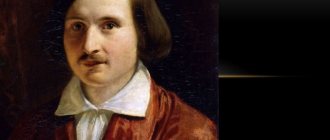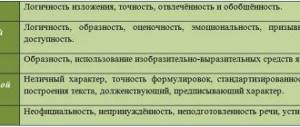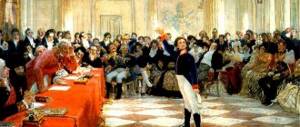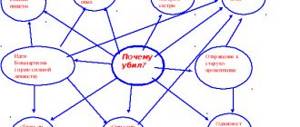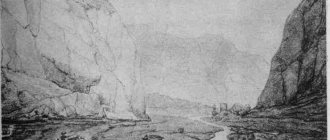Prigorok
Lesson 2. M. Gorky “Old Woman Izergil”
For a course, I once wrote a text about the problems of this story. I’ll insert it here at the beginning, so as not to repeat later what we will arrive at as the analysis progresses. And then I’ll write down possible questions and tasks.
M. Gorky's story “Old Woman Izergil” is simple for school analysis. 11th graders are quite capable of defining its issues; the main difficulty is insufficient knowledge of the context (this is the only story remaining in the program).
“Old Woman Izergil” is one of a number of romantic works in which the author consistently creates his own mythology - as opposed to the Christian worldview, which is unacceptable to him. Much has been written about the influence of the philosophy of F. Nietzsche on early Gorky, about the dream of both of them about a superman, too proud to humble himself before life or before God. At his first attempt to create the image of “his” hero, Gorky runs into a serious problem. His Loiko Zobar (story “Makar Chudra”) is young, handsome, free, he is a musician (the whole romantic set of a hero) and - most importantly - he is proud. But pride and love are antagonists (for the author, who grew up in the Christian tradition, this is obvious: pride is a satanic property, love is a divine one). In the plot of the story, this problem is implemented with great authorial honesty. Pride for both Loiko and Radda turns out to be stronger than love - and the heroes die. However, the author, as we will see, was not satisfied with such an “answer” to the problem he posed.
The second ideological problem that Gorky faces is the problem of death and the meaning of life. Proudly turning away from the immortality of the soul, the author risks finding himself in the same emptiness in which Bazarov felt: why work for the peasant if I, Evgeny Bazarov, will still grow into a mug? Gorky solves this problem (for himself) with the help of a legend. If even a shadow remains of a person - a fairy tale, a song, a legend - then he did not live his life in vain. Shadows running across the steppe become a metaphor for this ghostly, “legendary” immortality. Subsequently, Gorky will develop his myth: in the story “Old Woman Izergil”, Larra’s shadow will be contrasted with the sparks remaining from Danko’s burning heart. In “The Song of the Falcon,” the myth takes shape completely: drops of the blood of the deceased Falcon must turn into sparks (similar to those left from Danko’s heart) in order to ignite brave hearts with “a mad thirst for freedom and light.” This is precisely the immortality of those who “do not serve God and the Prophet” (in the words of old Rahim).
The third problem that Gorky consistently tries to solve in his early work is the search for a hero who could resist the “leaden abominations of life” and would help others get out “to freedom, to the light.” In reality, the author was unable to find such heroes, and he tried to create such an image at least in a romantic legend.
All three problems are present in the story “Old Woman Izergil”. How can we get the class to see them and formulate them?
The key in all three cases, in our opinion, may be the three-part composition of the story - a very striking feature that requires semantic explanation.
The easiest way to formulate the third problem (the problem of the “real” hero): just ask what the heroes of all three “short stories” have in common and in what ways they are opposed to each other. Of all the young handsome men who did not want to waste their lives vegetating “in the swamp” of everyday life, only Danko managed to bring other people into the light.
In order to see the second problem (immortality), you can start from the terrible naturalistic portrait of old Izergil: she is literally ready to become the land to which all flesh will return. What will remain of her life? Only stories. What else can remain of human life? Shadow or sparks are a metaphor from legends. Other immortality is shown in the story as a curse. But shadows and sparks are left only by those whose lives are worthy of legend. To live in such a way that a legend will be made about you—this is approximately how young Gorky understands the meaning of life.
The problem that remained unresolved in the story “Makar Chudra” will require comment. It can be shown by asking to list those traits of the heroes that the author himself admires. The class will name youth, beauty, strength - and pride. The heroes of all three parts of the story have these properties. Only their attitude towards other people differs - the ability to love and give (of themselves). Having received such an answer, we can tell how Gorky encountered in an earlier story the incompatibility of love and pride. And ask how he solves this problem here? We will again be helped by the clear antithesis on which the story is built. It presents two different “prides”: Larra’s pride - pride-exaltation before people, pride opposite to love - and Danko’s pride - pride directed against external circumstances, against the life that they are forced to drag out in the swamp. This pride does not contradict love for people. Gorky comes to this conclusion, and this idea will become his favorite for a long time. “Man” should sound proudly - this is perhaps the main postulate of Gorky’s worldview.
From this tongue twister we extract the actual questions. If possible, it would be good to read three texts: “Makara Chudra”, “Old Woman Izergil” and “Song of the Falcon”. Or at least those who will take the Unified State Exam must be given assignments on three stories at once, and let them be reports or something.
tasks (reports) look like this:
1) According to “Makar” and “Old Woman”: find descriptions of the characters , write down the most beautiful and characteristic details. Draw a conclusion: what, from the point of view of Gorky the romantic, should a person be?
2) For all three: what remains after a person’s death? How do these images (shadows and sparks) reflect Gorky’s idea of the meaning of life?
For everyone else (including those taking the exam), the task is classic :
— Explain how the three parts of the story are connected to each other: both “technically” and in meaning. (“Technically” it’s a ring composition, a narrator pulling stories out of an old woman, a landscape that creates a mood and from which plots emerge).
I usually start the lesson itself with an innocent question : there are legends that seem to be similar to folklore. Have you come across similar legends anywhere? What kind of “folklore” is used here?
People are usually surprised. Some people assume that the folklore is gypsy, but this is not so. I read gypsy fairy tales, they are completely different, very everyday and down to earth. The legend of Danko does not resemble anything at all - it is Gorky’s fantasy. But the legend of Larra is slightly reminiscent of the beginning of the Bible, the book of Genesis. Firstly, the surroundings: herds, elders... Secondly, the punishment of immortality is the punishment of Cain. Thirdly, the level of the problems discussed is completely biblical: life, death, good, evil... In essence, these are not “legends”, but “myths” that explain the essence of the world and human life - Gorky’s point of view. In other words, in this story he creates his own mythology, which is fundamentally different from the worldview contained in the Bible.
Next question : how to prove that the story is romantic? Give them two minutes to gather their thoughts, then quickly question them. It's easy.
— There is a dual world, and even a “double” one: there is the world of Russians (boring, senile) and the world of gypsies, who are ready to sing and dance all night. And there is a world of at least gypsy, but real life and a world of legends.
— Exoticism is present: the whole environment there is unusual, removed from the “typical circumstances” of Russian life. And the gypsies, and the landscape, and the narrator himself are a kind of free wanderer.
- The main thing is heroes. The exceptional, living an extraordinary life, opposed to the “crowd”.
Now you can listen to reports . Who, according to Gorky, is suitable for the role of a real romantic hero?
The best portrait is still from Loiko Zobar: “The eyes are like clear stars, and the smile is like the whole sun.” Simple and clear. Or you can read how he, a musician, emerges from the steppe.
So one night we were sitting and heard music floating across the steppe. Good music! The blood burned in her veins, and she called somewhere. We all felt that from that music we wanted something that would make us no longer need to live, or, if we were to live, then be kings over the whole earth, falcon! Here a horse was cut out of the darkness, and a man was sitting on it and playing, riding up to us. He stopped by the fire, stopped playing, smiling, looking at us. - Hey, Zobar, it's you! - Danilo shouted to him joyfully. So here he is, LoikoZobar! The mustache lay on the shoulders and mixed with the curls, the eyes glow like clear stars, and the smile is the whole sun, by God! It was as if he had been forged from one piece of iron along with the horse. He stands covered in blood, in the fire of a fire, and his teeth sparkle, laughing! I'll be damned if I didn't already love him as I loved myself, before he said a word to me or simply noticed that I, too, live in this world! Look, falcon, what kind of people there are! He will look into your eyes and fill your soul, and you will not be ashamed at all, but also proud for you. With such a person you become a better person. There are few such people, my friend! Well, okay, it was a problem. If there were a lot of good things in the world, it would not be considered good.
What does a person need? Youth, beauty, freedom, pride. What is not needed? Attachments and responsibilities. The latter usually angers the guys: who will work? But Gorky openly provokes the reader into indignation, demonstrating that traditional values are not a decree for him - he has others, his own, aesthetic and incompatible with traditional (Christian) morality. In a sense, this does not contradict romanticism: after all, a romantic hero could well be a romantic villain, as long as he was not an ordinary person.
What does a person do in life (if he does not work hard)? What is life in Gorky’s understanding?
It would be nice if someone found the literal wording in the “Song of the Falcon” - “the battle of life.” If we speak in the words of Izergil, feats are accomplished in life (“there is always a place for feats in life” - this has already turned into folklore).
Why are all these feats being performed?
Partly for the sake of “adrenaline” - so that life is not boring (these are mainly the “exploits” of Loiko Zobar). But generally, in order to leave behind a memory: a legend or a song. You must live in such a way that a song remains about you - this is the position of all Gorky’s romantic heroes. Therefore, in the end, a song is also sung about the Falcon (“to the madness of the brave”).
About pride, we can immediately clarify: what is the pride of Gorky’s heroes, what is its main nerve? “Probably in not obeying anyone.” Neither the beloved, nor the elders (the authorities - translated from mythological to everyday), nor generally accepted morality... God is not directly mentioned here (the censorship would not let it through), but the hint is transparent and understandable. Morality did not invent itself...
Next question : who is considered the romantic hero in “Old Woman Izergil”?
Obviously Danko and Larru. It is not obvious that Izergil herself (she is part of the “two worlds of the first order,” that is, she is the romantic heroine of relatively boring Russian readers). And her life partners will have equal rights with her, but this is already a corps de ballet.
So, the three main characters of the three parts of this story: Larra - Izergil - Danko. All of them (albeit to varying degrees) are romantic heroes. In other words, everyone corresponds to Gorky’s romantic ideal. We have come to the main domestic question: how are the parts connected to each other, why are the heroes compared?
If the class doesn’t tell you everything themselves (and it’s very possible that they will, it’s not that difficult), we’ll figure it out in two stages.
1) Compare Larra and Danko: what they have in common is the difference. The most interesting difference is in the quality of pride. For Larra it is that he does not want to submit to people, for Danko it is that he does not want to submit to circumstances . And he loves and pities people, although, however, he also stands above them and leads them along, and not vice versa. There is no talk of humility here and cannot be. It’s just that in a conflict with the crowd, Danko won - for a while, because the crowd later, of course, won back, trampling on his burning heart. It may be recalled that the technique of contrasting them is called antithesis - they will ask you in the exam.
2) Now we need to understand Izergil’s place in this system: why will she become a piece of land and not a legend? In what ways does it fall short of romantic heroes of the “highest order”? Someone will say: the only thing is that she is still alive. If there is no intelligible answer, you need to ask about how all three heroes think about their attitude towards people.
What does Larra want (and achieve)? - Take without giving anything in return. We need to find and read aloud his dialogue with the elders about how a person pays for everything with himself. This, in fact, is Gorky’s concept of the relationship between the individual and society.
What does Danko do if you look at his feat from the point of view of “take and give”? “He gives himself and doesn’t ask for anything in return.” As we can see, these are indeed extremes.
What is Izergil doing? – Takes and gives equally. She really is the “golden mean” here, but in the romantic system this is just not the best option. There are no songs or legends about the middle, which means that although life was lived to the fullest, it did not achieve its highest goal.
Now you can take advantage of the latest report from home preparations: what do people even live for? How does this manifest itself in their afterlife?
This is where the mythology described above (in italics) is built: a shadow remains from a romantic villain, a spark remains from a true hero, and these sparks have the property of igniting a thirst for “freedom, light” in the hearts of other people. And this is the immortality of those who do not believe in God and the immortality of the soul. And he believes, accordingly, in the progress and ascent of humanity along a spiral of endless development (the Marxist image, apparently, that inspired Gorky).
Now - to be sure - we can formulate the main problems raised in the story:
— The problem of death and immortality.
— The problem of the meaning of life (life and death).
— The problem of freedom (what is true freedom).
— The problem of a true hero.
— The problem of pride (an attempt to combine pride and love).
Having finished these conversations, it is necessary to show what the topics (C5) on “The Old Woman Izergil” look like.
Unified State Exam topics
— What is the meaning of the three-part composition in M. Gorky’s story “Old Woman Izergil”?
—What does Gorky the Romantic condemn and glorify in a person?
— What role does landscape play in the story “Old Woman Izergil”?
—For what purpose does Gorky use the device of antithesis in the story?
— What is the concept of life in the story “Old Woman Izergil”?
— How does the story reveal the theme of life and death?
— What is the ideal of a person in the romantic prose of M. Gorky?
— How do M. Gorky’s romantic heroes understand freedom?
We discussed everything except one thing – the landscape. You can ask D/Z: identify as many functions of the landscape in this story as possible and find an example in the text for each. The second part of the task relates to the play “At the Lower Depths”: to repeat the features of the “new drama”.
TARGET: understand the ideological and figurative content of the story, comprehend the features of Gorky’s romantic works, understand their special connection with life; deepen the student’s understanding of romanticism.
DURING THE CLASSES
1.Message sang and lesson objectives.
2. Conversation with the student on the following questions:
a/Who are the main characters of the story? What are the features of the composition?
b/What is the overall meaning of the work?
3.Write in a notebook a diagram showing the features of the composition of the story “Starvxa Izergil”.
The peculiarity of the composition is that, with internal unity of idea and tone, it consists of 3 independent episodes. The work has two narrators and, therefore, two narrative plans. The general narration is conducted on behalf of the author with his assessments and thoughts. The second narrator is the old woman Izergil, the bearer of folk legends about heroism, evil and good in human life.
4.Working with the text of a work of art.
Read the beginning of the story - a description of a mysterious and beautiful landscape and answer the question: What impression does the description of the grape pickers, the night landscape, the old woman Izergil leave?
5. Conversation with students on the following questions:
1. If you knew nothing about the life of Izergil herself, but only heard her legends, what idea would you have about this person? 2. Which ladies aroused contempt in Izergil, and which ones - love and admiration? Were there people capable of feats among those to whom she gave her love? 3. Is Izergil herself capable of accomplishing feats? But did she do it? What is a feat? 4. Why was Larra punished? What kind of pride is this that deserves punishment? 5. Is the feat of love and selfless service to people rewarded? 6. What did Danko do for people? At what point is his love for people most severely tested? 7. How did the tribesmen evaluate Danko’s feat?
6.Textological observations.
Landscape plays an important role in the story. Let's see how the writer depicts the forest, shows it as a force hostile to people, bringing them suffering and death. The stone trees “moved even more densely around the people in the evenings,” “there was a ring of strong darkness around those people, it was as if it was going to crush them,” “the forest hummed dully, as if it was threatening and singing a funeral song to those people.” The forest blocks the path forward - it is a formidable force that destroys people. When Danko tore his heart out of his chest and lit it on fire, people stood “amazed,” then they rushed after him, “enchanted,” “joyful and full of hope.” The forest was no less amazed. He could not resist the “torch of great love for people.” At first the forest “got silent,” then “it rustled again, shaking its tops in surprise,” and finally, it “gave way” in front of Danko and “stayed behind.”
7. Teacher’s word with elements of conversation:
The artistic features of the story clearly characterize Gorky's romantic style of writing. The writer primarily emphasizes the unusual, sublime and beautiful in people and nature. This is the background against which the old woman Izergil tells the story about Larra and Danko. Scraps of clouds of “lush, strange shapes and colors” wander across the sky. The sky is decorated with golden specks of stars. “All this - sounds and smells, clouds and people - was strangely beautiful and sad, it seemed like the beginning of a wonderful fairy tale.”
All the writer's means - abundantly used hyperbole, lyrically colored epithets, comparisons - are intended to create a certain heightened mood.
In “The Old Woman Izergil” there is an obvious connection with the romantic traditions in literature, especially with the traditions of Pushkin’s “southern poems”. The location of the action in "Gypsies" /Bessarabia/, the image of the old Gypsy, the exposure of the selfish Aleko - these motives, in a rethought form, found their expression in the story.
8. Conversation with students on the following questions:
a/ How does Izergil feel about Danko?
b/ What is the significance of her image for understanding Danko’s feat?
c/ Why is the story of Izergil placed between two legends? The image of Izergil helps to understand the author’s attitude towards the hero. Izergil admires Danko’s feat - a woman who loves beauty, yearns and thinks about “where the strong and beautiful people went from life.” It is no coincidence that the story of Izergil is placed between the legends of Larra and Danko. The old woman herself lived an interesting life in her own way, but she did not have lofty goals and ideals.
9.Textological observations.
If the forest symbolizes evil, a destructive force, then the steppe is a symbol of freedom, space, and joyful hopes. The beauty of the free steppe is associated with Danko’s selfless act. The writer makes you feel this by comparing the color of the river with the hero’s blood.
Observing the language of descriptions of the forest and steppe, we see the confrontation between light and darkness, freedom and bondage. It was the light that won, dispelled the darkness, the ring of which “was about to crush” people. And the forest fell silent, stopped and parted before the people, because it was illuminated by a bright light.
HOMEWORK
Learn by heart an excerpt from the legend of Danko. Make a comparative description of Larra and Danko.
